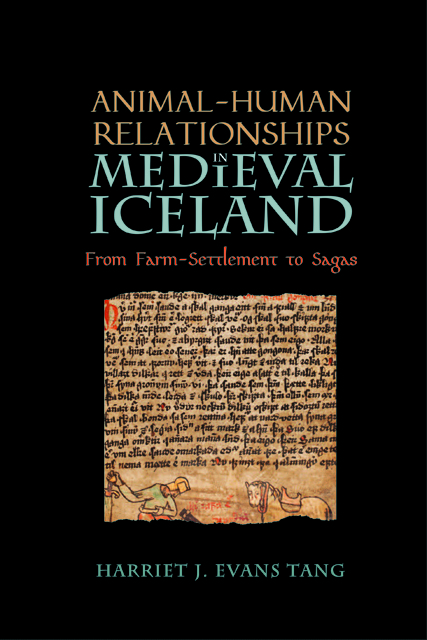Book contents
- Frontmatter
- Dedication
- Contents
- List of Illustrations
- Acknowledgements
- Note on Translations
- The Animal Acts …
- 1. An Animal-Human Settlement
- 2. Home, Sweet Home: Meeting Points on the Animal-Human Farm
- 3. The Animal-Human Community: Legal Tradition in Iceland
- 4. Fostering Relations: The Animal-Human Home in the Íslendingasögur
- 5. The Negative Animal: Absence, Precarity, and Danger
- … And the Man Responds
- Bibliography
- Index
- Nature and Environment in the Middle Ages
2. - Home, Sweet Home: Meeting Points on the Animal-Human Farm
Published online by Cambridge University Press: 11 January 2023
- Frontmatter
- Dedication
- Contents
- List of Illustrations
- Acknowledgements
- Note on Translations
- The Animal Acts …
- 1. An Animal-Human Settlement
- 2. Home, Sweet Home: Meeting Points on the Animal-Human Farm
- 3. The Animal-Human Community: Legal Tradition in Iceland
- 4. Fostering Relations: The Animal-Human Home in the Íslendingasögur
- 5. The Negative Animal: Absence, Precarity, and Danger
- … And the Man Responds
- Bibliography
- Index
- Nature and Environment in the Middle Ages
Summary
Having started the thread of this book with the physical and ideological settlement of Iceland, this chapter will dig deeper into the settlements themselves, to investigate the ways in which the building and development of farms might be said to influence and be influenced by animals and their relationships with humans. The act of building, and where and how one builds, codifies conscious decisions to dwell in a certain way, which create and enable meeting points: encounters between agents that can leave lasting impressions in the material record and, I would argue, in the stories of places. This chapter will focus on potential meeting points between animals and humans in the physical remains of the Viking-Age Icelandic farm, drawing on not only the more substantial animal places on sites, such as byres, but also more ambiguous features that may have been formed from the actions of animals. It aims to demonstrate the value of thinking about the experiences of animals when interpreting archaeological sites and reconstructing the ways in which humans would have experienced animals. Meeting points like those discussed below would have formed the roots of the literary and legal depictions of animal-human relationships discussed in the proceeding chapters, and a grounded approach to animal-human relations in the medieval Icelandic imagination and experience necessarily requires examining the places of interaction on the physical farm. By applying spatial analysis, in conjunction with the data from careful excavation and post-excavation analyses (where available), a cycle of animal-human interactions and relationships at archaeological sites can be investigated. These sites and these relationships show us some threads of the wider multispecies communities that produced the legal ideals and regulations discussed in Chapter 3, and the saga literature analysed in Chapters 4 and 5.
The space of the farm was built in a specific way, with preconceived ideas of how animals and humans should relate to each other, in turn shaped by the taskscape of the farm: that is, the daily ensemble of tasks that constituted dwelling, performed by both humans and animals as agents working together in the business of settling and subsisting within the Icelandic environment.
- Type
- Chapter
- Information
- Animal-Human Relationships in Medieval IcelandFrom Farm-Settlement to Sagas, pp. 60 - 105Publisher: Boydell & BrewerPrint publication year: 2022



